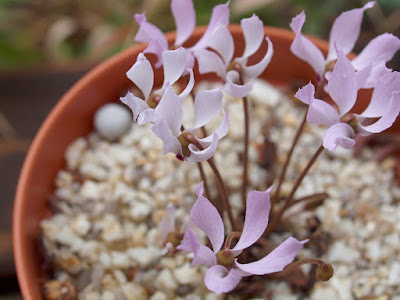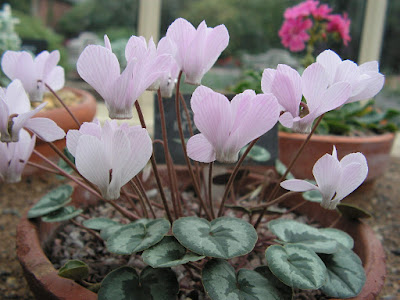Cyclamen mirabile is native to Turkish pine woodland and maquis in southwestern Turkey. It grows in sandy or gritty soil from the underlying mica schist but also over conglomerate and occasionally limestone, in partial shade at the edge of evergreen oak scrub or rocks, in sparse coniferous woodland and sometimes deciduous woodland.
Cyclamen mirabile also called as Sowbread, is a species in the Cyclamen genus. This species was first described by Friedrich Hermann Gustav Hildebrand in 1906.
IDENTIFY CYCLAMEN MIRABILE - SOWBREAD
Cyclamen mirabile is native to Turkish pine woodland and maquis in southwestern Turkey. It grows in sandy or gritty soil from the underlying mica schist but also over conglomerate and occasionally limestone, in partial shade at the edge of evergreen oak scrub or rocks, in sparse coniferous woodland and sometimes deciduous woodland.
It is a herbaceous perennial growing from a depressed-globose tuber and to 6 cm (2.3 in), rarely larger, corky and fissured when mature, and rooting from the lower surface. The leaves appear in autumn and are heart-shaped, appear about the same time as the flowers have a hastate pattern in grey-green, cream or silver and scalloped margins. Sometimes the new leaves are flushed pink.
Sowbread blooms in autumn. It has pale to deep pink flowers with toothed petal lobes and a stain around the mouth. The flowers have a coconut scent.
Cyclamen mirabile 'Tilebarn Anne', a selection from by Peter Moore, has pink flowers and bright silvery leaves with etched leaves, flushed pink at first.
Cyclamen mirabile 'Tilebarn Jan', was selected from seed over several generations from Peter Moore to produce plants with white flowers, a pink nose, and petals with a serrated margin. Leaves are flushed pink as they unfurl.
Cyclamen mirabile 'Tilebarn Nicholas' , a selection from Peter Moore, has leaves with a green tree shaped center surrounded by a silver band. The young leaves have a pink tinge that fades with time.
CYCLAMEN MIRABILE - SOWBREAD CARE AND CULTURE
Cultural information should only be used as a guide, and should be to be adapted to suit you. Your physical location; where you grow your plants, how much time you have to devote to their care, and many other factors, will need to be taken into account. Only then can you decide on the cultural methods that best suit you and your plants.
Light:
Cyclamen mirabile prefers bright, filtered light, but keep it out of direct sunlight, which might scorch the leaves. This plant does not perform well in low light. Near a sunny window is preferred. From late autumn to early spring, provide your plant with as much light as possible. Sunburn is usually not an issue this time of year, although you may want to avoid placing your plant directly in front of a south-facing window.
Temperature:
Keep the plant cool at all times, so that its flowers last‐longer. Warmer temperatures will shorten the plant's life. Do not place on or near any heat source, like a vent, a fireplace or a television set. Daytime temperatures of 65 to 70°F are ideal. They prefers cooler temperatures at night, preferably between 40 and 50°F. It will however tolerate evening temperatures up to 65°F.
Humidity:
High humidity, especially during winter, is crucial. Keep the plant on a tray of water with a layer of pebbles or something else to form a shelf for the plant pot to sit on. Do not let the plant itself sit in the water. To prevent disease problems, it is also a good idea to maintain good air movement around the plant.
Substrate and growing media:
Sowbread prefer poor, well-drained soils. Grown indoors, they needs a mixture of equal parts houseplant potting soil and peat moss, with half the crown above the soil. When grown outdoors, they are at their happiest around the base of deciduous trees and large shrubs. These are areas that are cool and shady in the summer but light and moist during the autumn and winter.
Watering:
Watering incorrectly can cause many problems, especially when too much water has been applied. Always wait until the soil surface feels dry before you water, but don't wait until the plant becomes limp. Do not water the center of the plant or the tuber may rot. The plants prefers to receive a good soaking, then dry out partially before receiving a good soaking again. Allow the plant to drain over a sink or empty the water collection tray beneath the container after a few minutes. This will help prevent the roots from remaining too wet, which can lead to rotting.
Fertilizer:
Fertilize your plant with a water-soluble fertilizer recommended for use on indoor plants, mixed half strength. Apply it every 3 or 4 weeks, starting about a month after you receive the plant. Overfeeding is more likely to produce foliage than flowers.
Pruning:
Dead flowers or leaves should be removed by giving their stems a sharp tug. If a sharp tug doesn't remove them, wait another day and try again. You don't want to risk yanking out a chunk of the tuber along with other healthy leaves.
Rest period:
Cyclamen mirabile requires a rest period after flowering. In nature it goes dormant during the summer months, comes into growth as cooler, damper weather starts, flowers in autumn, winter or spring, and goes dormant again as the summer becomes warm. Stop watering when the leaves turn yellow and wither. Keep the pot in a cool place, if possible, and allow the soil to become dry. It may be placed outdoors during the summer in a location where rainfall won't reach it, out of direct sunlight. Once all the leaves have dried, a process that could take up to two months, the tuber may be repotted into a container that is 1 inch larger in diameter than the old pot. This is usually necessary only every 2 years. Use a packaged, peaty soil mixture. The top half of the tuber should protrude above the soil line to assure adequate drainage and avoid tuber rot. Do not water it, as this could trigger new growth prematurely.
In fall when new leaves start to grow, water the soil thoroughly. If you have trouble getting the potting soil to take up water, add a couple drops of hand dish-washing detergent to the water. This will not harm the plant, but will act as a wetting agent. If new growth hasn't occurred by late October you can go ahead and water it. As long as the tubers are still plump and hard, they should be okay. Wait for shoots to appear and the soil to become rather dry - then water thoroughly again.
Propagation:
The plants are commercially propagated from seed: Sow seed on the media surface approximately 1/2 to 213 covered in a media with a pH of 6.0-6.5. Germinate at 65-68°F in a germination chamber maintained at 100% humidity using a mist or fog system in the dark. Seed will germinate in 3-4 weeks.
Flower induction:
The plants initiate flowers in the 6th leaf axil when 10- 13 leaves have unfolded. The plant will continue to produce a flower, then a leaf, then a flower in an alternating fashion for up approx. 3 months. however, the total amount of light delivered daily affects earliness of flowering and development. Optimal light intensity and photoperiod is 500 foot-candles for 16 hrs/day prior to flower initiation. Optimal light intensity after flower initiation is 850-1,000 foot-candles for 16 hrs/day.
Pests and diseases:
The plants can develop thrip, fungus gnat and/or mite infestations. Control is achieved by removing infected plants and controlling thrips. They are susceptible to TSWV/INSV, root rot pathogens, Fusarium wilt, Bacterial wilt (Ewinia spp.) and Botrytis.


















COMMENTS